
1860s in fashion
Encyclopedia
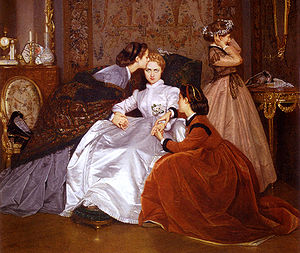
Clothing
Clothing refers to any covering for the human body that is worn. The wearing of clothing is exclusively a human characteristic and is a feature of nearly all human societies...
is characterized by extremely full-skirted women's fashions relying on crinoline
Crinoline
Crinoline was originally a stiff fabric with a weft of horse-hair and a warp of cotton or linen thread. The fabric first appeared around 1830, but by 1850 the word had come to mean a stiffened petticoat or rigid skirt-shaped structure of steel designed to support the skirts of a woman’s dress into...
s and hoops and the emergence of "alternative fashions" under the influence of the Artistic Dress movement
Artistic Dress movement
The Artistic Dress movement and its successor, Aesthetic Dress, were fashion trends in nineteenth century clothing that rejected the highly structured and heavily trimmed Paris fashion of the day in favour of beautiful materials and simplicity of design....
.
In men's fashion, the three-piece ditto suit
Ditto suit
The ditto suit is an early precursor of the lounge suit but often had a coat more akin to a frock coat or morning coat. That the waistcoat and trousers were matching made the suit more informal than those with silk faced lapels worn with formal striped trousers.-External links:* on display at the...
of sack coat, waistcoat, and trousers in the same fabric emerged as a novelty.
Women's fashions
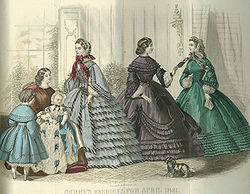
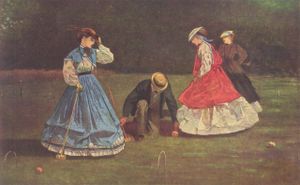
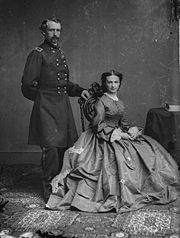
Colors
Aniline dyesMauveine
Mauveine, also known as aniline purple and Perkin's mauve, was the first synthetic organic chemical dye.Its chemical name is3-amino-2,±9-dimethyl-5-phenyl-7-phenazinium acetate...
were discovered in 1856 and quickly became fashionable colors. The first ones were mauve and bright purple. In 1860, two fashionable brilliant pink aniline dyes were named after battles in Italy's fight for independence
Italian unification
Italian unification was the political and social movement that agglomerated different states of the Italian peninsula into the single state of Italy in the 19th century...
: magenta
Magenta
Magenta is a color evoked by light stronger in blue and red wavelengths than in yellowish-green wavelengths . In light experiments, magenta can be produced by removing the lime-green wavelengths from white light...
, named after the Italian town of Magenta, Lombardy, and the similar solferino, named after Solferino
Solferino
Solferino is a small town and comune in the province of Mantua, Lombardy, northern Italy, approximately 10 kilometres south of Lake Garda....
. Magenta was popularized in England by the Duchess of Sutherland
Anne Sutherland-Leveson-Gower, Duchess of Sutherland
Anne Sutherland-Leveson-Gower, Duchess of Sutherland , 1st Countess of Cromartie in her own right and known as the Marchioness of Stafford from 1849 to 1861, was a British peeress....
after she was appealed to by the Spitalfields
Spitalfields
Spitalfields is a former parish in the borough of Tower Hamlets, in the East End of London, near to Liverpool Street station and Brick Lane. The area straddles Commercial Street and is home to many markets, including the historic Old Spitalfields Market, founded in the 17th century, Sunday...
silk weavers.
Gowns
By the early 1860s, skirtSkirt
A skirt is a tube- or cone-shaped garment that hangs from the waist and covers all or part of the legs.In the western world, skirts are usually considered women's clothing. However, there are exceptions...
s had reached their ultimate width. After about 1862 the silhouette of the crinoline changed and rather than being bell-shaped it was now flatter at the front and projected out more behind. http://www.vam.ac.uk/collections/fashion/features/corset/1830/index.html
Day dresses featured wide pagoda sleeve
Sleeve
Sleeve is that part of a garment which covers the arm, or through which the arm passes or slips. The pattern of the sleeve is one of the characteristics of fashion in dress, varying in every country and period...
s worn over undersleeves or engageante
Engageante
Engageantes are false sleeves worn with women's clothing in the 18th and 19th centuries.In the 18th century, engageantes took the form of ruffles or flounces of linen, cotton, or lace, tacked to the elbow-length sleeves then fashionable....
s. High necklines with lace
Lace
Lace is an openwork fabric, patterned with open holes in the work, made by machine or by hand. The holes can be formed via removal of threads or cloth from a previously woven fabric, but more often open spaces are created as part of the lace fabric. Lace-making is an ancient craft. True lace was...
or tatted
Tatting
Tatting is a technique for handcrafting a particularly durable lace constructed by a series of knots and loops. Tatting can be used to make lace edging as well as doilies, collars, and other decorative pieces. The lace is formed by a pattern of rings and chains formed from a series of cow hitch,...
collars
Collar (clothing)
In clothing, a collar is the part of a shirt, dress, coat or blouse that fastens around or frames the neck. Among clothing construction professionals, a collar is differentiated from other necklines such as revers and lapels, by being made from a separate piece of fabric, rather than a folded or...
or chemisette
Chemisette
A Chemisette is an article of women's clothing worn to fill in the front and neckline of any garment. Chemisettes give the appearance of a blouse or shirt worn under the outer garment without adding bulk at the waist or upper arm.Chemisettes of linen or cotton were often worn with day dresses in...
s completed the demure daytime look.
Evening gowns had low necklines and short sleeves, and were worn with short glove
Glove
A glove is a garment covering the hand. Gloves have separate sheaths or openings for each finger and the thumb; if there is an opening but no covering sheath for each finger they are called "fingerless gloves". Fingerless gloves with one large opening rather than individual openings for each...
s or lace
Lace
Lace is an openwork fabric, patterned with open holes in the work, made by machine or by hand. The holes can be formed via removal of threads or cloth from a previously woven fabric, but more often open spaces are created as part of the lace fabric. Lace-making is an ancient craft. True lace was...
or crochet
Crochet
Crochet is a process of creating fabric from yarn, thread, or other material strands using a crochet hook. The word is derived from the French word "crochet", meaning hook. Hooks can be made of materials such as metals, woods or plastic and are commercially manufactured as well as produced by...
ed fingerless mitt
Mitt
Mitt can refer to:*a woman's glove that extends over the hand but does not cover the fingers*mitten, glove that does not have separate fingers*one of two types of baseball glove worn by a catcher or first baseman*abbreviation for Military transition team...
s. Large crinolines were probably reserved for special occasions.
Skirts were now assembled of shaped panels, since gathering a straight length of fabric could not provide the width required at the hem without unwanted bulk at the waist; this spelled the end of the brief fashion for border-printed dress fabrics.
Heavy silk
Silk
Silk is a natural protein fiber, some forms of which can be woven into textiles. The best-known type of silk is obtained from the cocoons of the larvae of the mulberry silkworm Bombyx mori reared in captivity...
s in solid colors became fashionable for both day and evening wear, and a skirt might be made with two bodice
Bodice
A bodice, historically, is an article of clothing for women, covering the body from the neck to the waist. In modern usage it typically refers to a specific type of upper garment common in Europe during the 16th to the 18th century, or to the upper portion of a modern dress to distinguish it from...
s, one long-sleeved and high necked for afternoon wear and one short-sleeved and low-necked for evening.
As the decade progressed, sleeves narrowed, and the circular hoops of the 1850s
1850s in fashion
1850s fashion in Western and Western-influenced clothing is characterized by an increase in the width of women's skirts supported by crinolines or hoops, and the beginnings of dress reform.-Gowns:...
decreased in size at the front and sides and increased at the back. Looped up overskirts revealed matching or contrasting underskirts, a look that would reach its ultimate expression the next two decades with the rise of the bustle
Bustle
A bustle is a type of framework used to expand the fullness or support the drapery of the back of a woman's dress, occurring predominantly in the mid-to-late 19th century. Bustles were worn under the skirt in the back, just below the waist, to keep the skirt from dragging. Heavy fabric tended to...
. Waistlines rose briefly at the end of the decade.
Fashions were adopted more slowly in America
United States
The United States of America is a federal constitutional republic comprising fifty states and a federal district...
than in Europe. It was not uncommon for fashion plate
Fashion plate
A fashion plate is an illustration demonstrating the highlights of fashionable styles of clothing. Fashion plates are not depictions of specific people, but are instead generalized portraits, meant only to dictate the style of clothes that a tailor, dressmaker, or store could make or sell, or to...
s to appear in American women's magazine
Magazine
Magazines, periodicals, glossies or serials are publications, generally published on a regular schedule, containing a variety of articles. They are generally financed by advertising, by a purchase price, by pre-paid magazine subscriptions, or all three...
s a year or more after they appeared in Paris
Paris
Paris is the capital and largest city in France, situated on the river Seine, in northern France, at the heart of the Île-de-France region...
or London
London
London is the capital city of :England and the :United Kingdom, the largest metropolitan area in the United Kingdom, and the largest urban zone in the European Union by most measures. Located on the River Thames, London has been a major settlement for two millennia, its history going back to its...
.
Outerwear
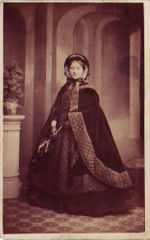
Three-quarter-length capes (with or without sleeves) were also worn.
For walking, jackets were accompanied by floor-length skirts that could be looped or drawn up by means of tapes over a shorter petticoat.
Riding habit
Riding habit
A riding habit is women's clothing for horseback riding.Since the mid-17th century, a formal habit for riding sidesaddle usually consisted of:* A tailored jacket with a long skirt to match* A tailored shirt or chemisette...
s had fitted jackets with long sleeves, worn over a collared shirt or (more often) chemisette. They were worn with long skirts and mannish top hats.
Undergarments
As skirts became narrower and flatter in front, more emphasis was placed on the waist and hips. A corsetCorset
A corset is a garment worn to hold and shape the torso into a desired shape for aesthetic or medical purposes...
was therefore used to help mold the body to the desired shape. This was achieved by making the corsets longer than before, and by constructing them from separate shaped pieces of fabric. To increase rigidity, they were reinforced with many strips of whalebone, cording, or pieces of leather. As well as making corsets more constricting, this heavy structure helped prevent them from riding up, or from wrinkling at the waist. Steam-molding also helped create a curvaceous contour. Developed by Edwin Izod in the late 1860s, the procedure involved placing a corset, wet with starch, on a steam heated copper torso form until it dried into shape.
The crinoline
Crinoline
Crinoline was originally a stiff fabric with a weft of horse-hair and a warp of cotton or linen thread. The fabric first appeared around 1830, but by 1850 the word had come to mean a stiffened petticoat or rigid skirt-shaped structure of steel designed to support the skirts of a woman’s dress into...
or hooped petticoat had grown to its maximum dimensions by 1860. As huge skirts began to fall from favor, around 1864, the shape of the crinoline began to change. Rather than being dome-shaped, the front and sides began to contract, leaving volume only at the back. The "American" cage, a hooped petticoat partially covered in fabric, came in bright colors made possible by the new aniline dyes. This was followed by a hybrid of the bustle
Bustle
A bustle is a type of framework used to expand the fullness or support the drapery of the back of a woman's dress, occurring predominantly in the mid-to-late 19th century. Bustles were worn under the skirt in the back, just below the waist, to keep the skirt from dragging. Heavy fabric tended to...
and crinoline sometimes called a "crinolette". The cage structure was still attached around the waist and extended down to the ground, but only extended down the back of the wearer’s legs. The crinolette itself was quickly superseded by the true bustle, which was sufficient for supporting the drapery and train at the back of the skirt.
Military and political influences
The Garibaldi shirtGaribaldi shirt
A Garibaldi shirt was a woman's fashion, a red wool shirt named after the Italian patriot Giuseppe Garibaldi first popularized in 1860. It was the direct ancestor of the modern women's blouse.-Garibaldi's Redshirts:...
or "Garibaldi jacket" was popularized by Empress Eugénie
Eugénie de Montijo
Doña María Eugenia Ignacia Augustina de Palafox-Portocarrero de Guzmán y Kirkpatrick, 16th Countess of Teba and 15th Marquise of Ardales; 5 May 1826 – 11 July 1920), known as Eugénie de Montijo , was the last Empress consort of the French from 1853 to 1871 as the wife of Napoleon III, Emperor of...
of France in 1860. These bright red woolen garments featured black embroidery
Embroidery
Embroidery is the art or handicraft of decorating fabric or other materials with needle and thread or yarn. Embroidery may also incorporate other materials such as metal strips, pearls, beads, quills, and sequins....
or braid
Trim (sewing)
Trim or trimming in clothing and home decorating is applied ornament, such as gimp, passementerie, ribbon, ruffles, or, as a verb, to apply such ornament....
and military details. Following a visit by the Italian revolutionary Giuseppe Garibaldi
Giuseppe Garibaldi
Giuseppe Garibaldi was an Italian military and political figure. In his twenties, he joined the Carbonari Italian patriot revolutionaries, and fled Italy after a failed insurrection. Garibaldi took part in the War of the Farrapos and the Uruguayan Civil War leading the Italian Legion, and...
to England
England
England is a country that is part of the United Kingdom. It shares land borders with Scotland to the north and Wales to the west; the Irish Sea is to the north west, the Celtic Sea to the south west, with the North Sea to the east and the English Channel to the south separating it from continental...
in 1863, the shirt became all the rage there. In America
United States
The United States of America is a federal constitutional republic comprising fifty states and a federal district...
, the early years of the Civil War
American Civil War
The American Civil War was a civil war fought in the United States of America. In response to the election of Abraham Lincoln as President of the United States, 11 southern slave states declared their secession from the United States and formed the Confederate States of America ; the other 25...
also saw increased popularity of military-influenced styles such as Zouave
Zouave
Zouave was the title given to certain light infantry regiments in the French Army, normally serving in French North Africa between 1831 and 1962. The name was also adopted during the 19th century by units in other armies, especially volunteer regiments raised for service in the American Civil War...
jackets. These new styles were worn over a waist (blouse
Blouse
A blouse is a loose-fitting upper garment that was formerly worn by workmen, peasants, artists, women and children. It is typically gathered at the waist so that it hangs loosely over the wearer's body. Today, the word most commonly refers to a woman's shirt but can also refer to a man's shirt if...
) or chemisette
Chemisette
A Chemisette is an article of women's clothing worn to fill in the front and neckline of any garment. Chemisettes give the appearance of a blouse or shirt worn under the outer garment without adding bulk at the waist or upper arm.Chemisettes of linen or cotton were often worn with day dresses in...
and a skirt with a belt
Belt (clothing)
A belt is a flexible band or strap, typically made of leather or heavy cloth, and worn around the waist. A belt supports trousers or other articles of clothing.-History:...
at the natural waistline. Women's fashion overall was highly influenced by the reigning Queen Victoria of England.
Rise of haute couture
The Englishman Charles Frederick WorthCharles Frederick Worth
Charles Frederick Worth , widely considered the Father of Haute couture, was an English fashion designer of the 19th century, whose works were produced in Paris.-Career:...
had established his first fashion house
Fashion House
Fashion House is an American telenovela that aired at 9 p.m. ET/8 p.m. CT Monday through Saturday on MyNetworkTV stations. The series premiered on September 5, 2006 and concluded on December 5, 2006...
in Paris in 1858. He was the first couturier
Couturier
A couturier is an establishment or person involved in the clothing fashion industry who makes original garments to order for private clients. A couturier may make what is known as haute couture. Such a person usually hires patternmakers and machinists for garment production, and is either employed...
, a dressmaker
Dressmaker
A dressmaker is a person who makes custom clothing for women, such as dresses, blouses, and evening gowns. Also called a mantua-maker or a modiste.-Notable dressmakers:*Cristobal Balenciaga*Charles Frederick Worth...
considered an artist, and his ability to dictate design in the 1860s lead to the dominance of Parisian haute couture
Haute couture
Haute couture refers to the creation of exclusive custom-fitted clothing. Haute couture is made to order for a specific customer, and it is usually made from high-quality, expensive fabric and sewn with extreme attention to detail and finished by the most experienced and capable seamstresses,...
for the next hundred years.
Artistic dress
The followers of the Pre-Raphaelite BrotherhoodPre-Raphaelite Brotherhood
The Pre-Raphaelite Brotherhood was a group of English painters, poets, and critics, founded in 1848 by William Holman Hunt, John Everett Millais and Dante Gabriel Rossetti...
and other artistic reformers objected to the elaborately trimmed
Trim (sewing)
Trim or trimming in clothing and home decorating is applied ornament, such as gimp, passementerie, ribbon, ruffles, or, as a verb, to apply such ornament....
confections of high fashion with their emphasis on rigid corset
Corset
A corset is a garment worn to hold and shape the torso into a desired shape for aesthetic or medical purposes...
s and hoops as both ugly and dishonest. An "anti-fashion" for Artistic dress
Artistic Dress movement
The Artistic Dress movement and its successor, Aesthetic Dress, were fashion trends in nineteenth century clothing that rejected the highly structured and heavily trimmed Paris fashion of the day in favour of beautiful materials and simplicity of design....
spread in the 1860s in literary and artistic circles, and remained an undercurrent for the rest of the century. The style was characterised by "medieval" influences such as juliette sleeves
Sleeve
Sleeve is that part of a garment which covers the arm, or through which the arm passes or slips. The pattern of the sleeve is one of the characteristics of fashion in dress, varying in every country and period...
, the soft colors of vegetable dye
Dye
A dye is a colored substance that has an affinity to the substrate to which it is being applied. The dye is generally applied in an aqueous solution, and requires a mordant to improve the fastness of the dye on the fiber....
s, narrow skirts, and simple ornamentation with hand embroidery
Embroidery
Embroidery is the art or handicraft of decorating fabric or other materials with needle and thread or yarn. Embroidery may also incorporate other materials such as metal strips, pearls, beads, quills, and sequins....
.
Hairstyles and headgear
Hair was worn parted in the middle and smoothed, waved, or poofed over the ears, then braided or "turned up" and pinned into a roll or low bun at the back of the neck. Such styling was usually maintained by the use of hair oils and pomades.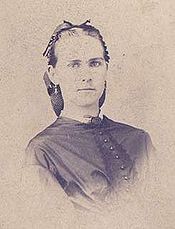
Snood (headgear)
A snood is historically a type of European female headgear, or in modern times a tubular neck scarf. In the most common form the headgear resembles a close-fitting hood worn over the back of the head...
" (NOTE: "snood" is a modern term used by some re-enactors), especially by younger women. These hairnets were frequently made of very fine material to match the wearer's natural hair color, but occasionally more elaborate versions were made of thin strips of velvet or chenille (sometimes decorated with beads). Whether plain or resplendent, many hairnets were edged with ruchings of ribbon that would serve to adorn the crown of the wearer's head.
Fashion Bonnet
Bonnet (headgear)
Bonnets are a variety of headgear for both sexes, which have in common only the absence of a brim. Bonnet derives from the same word in French, where it originally indicated a type of material...
s for outdoor wear had small brims that revealed the face. Earlier bonnets of the decade had lower brims. However, by mid-century Spoon Bonnets, which featured increasingly high brims and more elaborate trimmings, became the vogue. Other less common variants, such as the Marie Stuart Bonnet, with its heart-shaped brim, and the fanchon bonnet, with its very short brim and back curtain, made appearances in the realm of fashionable headwear.
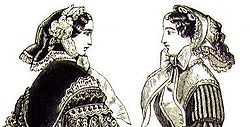
Trimmings varied according to the changing styles and whims of the individual wearer, but most bonnets of the period followed some general rules with regards to form. Rows of gathered net lining the brim was a fashion carry-over from the decade before, and a decorative curtain (also referred to as a "bavolet") appeared on most bonnets in order to shade the wearer's neck and accommodate for the low hairstyles. Another standard of 1860s bonnets is bonnet ties. There were often two sets, a thin pair of "utility ties" to take the strain of tying the bonnet, and another set of wide ties of silk or another fancy material. These rich ties were tied below the chin in a bow or left untied to show off the beautiful print or material.
Bonnets fell out of fashion over the decade in favor of small hats.
Style gallery 1860–1864
- Day dresses from around 1860 with full skirts held out by crinolines
- Evening gowns from the early 1860s.
- Italian woman wears a gray striped jacket with turned-back pagoda sleeves trimmed in contrasting fabric and a matching skirt. Her blouse sleeves or engageantes are full over her lower arms, 1861.
- 1862 portrait of Jenny LindJenny LindJohanna Maria Lind , better known as Jenny Lind, was a Swedish opera singer, often known as the "Swedish Nightingale". One of the most highly regarded singers of the 19th century, she is known for her performances in soprano roles in opera in Sweden and across Europe, and for an extraordinarily...
depicts her in a white evening gown with a wide lace collar. Her hair is parted in the center, rolled or "turned up" at the sides, and decorated with flowers. - Vienna fashion plate, showing male and female attire.
- Artistic dress has romantic, vaguely medieval lines with a slight train, and is worn without a corset or hoops. This young girl wears her hair down. 1862.
- Zouave jacket in bright red with ball fringe and braid trim is waist length and cutaway in front, 1864.
- Fashion plate of 1864 shows the fashionable braided Zouave-style cutaway jacket worn with a shirtwaist (blouse), skirt, and wide belt. The lady on the right wears a knee-length velvet coat.
Style gallery 1865–1866
- Emilia Włodkowska wears a bronze-colored satin evening gown with bands of trim on the skirt, 1865.
- The Empress Elisabeth in evening dress, 1865. The skirt has an overlayer of sheer fabric called illusion and is noticeably fuller in back than in front, the first hint of the styles that would prevail in the next decade.
- Clara Barton wears a typical American hairstyle of 1865–66.
- Countess Karoly wears her hair in a net or snood. Her hat is tipped forward over her forehead, and is trimmed with ostrich plumes, 1865.
- Ellinor Guthrie wears a black satin dress trimmed with passementeriePassementeriePassementerie or passementarie is the art of making elaborate trimmings or edgings of applied braid, gold or silver cord, embroidery, colored silk, or beads for clothing or furnishings....
, 1865. - English shot (changeable) silk taffeta day dress is trimmed with silk satin and machine-made lace, c. 1865. Los Angeles County Museum of ArtLos Angeles County Museum of ArtThe Los Angeles County Museum of Art is an art museum in Los Angeles, California. It is located on Wilshire Boulevard along Museum Row in the Miracle Mile vicinity of Los Angeles, adjacent to the George C. Page Museum and La Brea Tar Pits....
, M.2007.211.942a-b. - Emilie Menzel wears her hair in a net snood. Her day dress has a pointed waist and slightly puffed, long sleeves, 1866.
Style gallery 1867–1869
- Riding habits of 1867 feature short ot hip-length jackets and trailing petticoats for riding sidesaddle.
- Margherita of Savoy-Genoa wears an outdoor walking costume consisting of a loose jacket and matching skirt. The skirt is drawn up for ease of walking over an ankle-length underskirt or petticoat and hoops. She wears a bowler-like hat wrapped in a scarf or veil. Latter half 1860s.
- Fashions of 1869 show a high waist and an elliptical skirt. Draped styles suggest a separate underskirt or petticoat. Jackets are knee-length.
- Fashions from The Englishwoman's Domestic MagazineThe Englishwoman's Domestic MagazineThe Englishwoman's Domestic Magazine was a magazine published by Samuel Orchart Beeton from 1852 to 1879, with a supplement written by his wife Mrs Beeton between 1859 and 1861: these supplements were later collected as her Book of Household Management. His intention was that it should "tend to...
, 1869, show the beginnings of the bustle: high-waisted skirts are looped up over underskirts. Hats are worn tipped forward over the forehead, and short gloves are worn with long, tight sleeves. - Photo of bustle cage crinolineCrinolineCrinoline was originally a stiff fabric with a weft of horse-hair and a warp of cotton or linen thread. The fabric first appeared around 1830, but by 1850 the word had come to mean a stiffened petticoat or rigid skirt-shaped structure of steel designed to support the skirts of a woman’s dress into...
(1862–70) and split-busk corsetCorsetA corset is a garment worn to hold and shape the torso into a desired shape for aesthetic or medical purposes...
(1865–75), Los Angeles County Museum of ArtLos Angeles County Museum of ArtThe Los Angeles County Museum of Art is an art museum in Los Angeles, California. It is located on Wilshire Boulevard along Museum Row in the Miracle Mile vicinity of Los Angeles, adjacent to the George C. Page Museum and La Brea Tar Pits....
M.2007.211.386, M.2007.211.360
Men's fashion
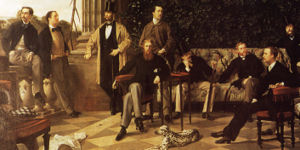
Shirt
Shirt
A shirt is a cloth garment for the upper body. Originally an undergarment worn exclusively by men, it has become, in American English, a catch-all term for almost any garment other than outerwear such as sweaters, coats, jackets, or undergarments such as bras, vests or base layers...
s of linen or cotton featured high upstanding or turnover collars
Collar (clothing)
In clothing, a collar is the part of a shirt, dress, coat or blouse that fastens around or frames the neck. Among clothing construction professionals, a collar is differentiated from other necklines such as revers and lapels, by being made from a separate piece of fabric, rather than a folded or...
, and necktie
Necktie
A necktie is a long piece of cloth worn for decorative purposes around the neck or shoulders, resting under the shirt collar and knotted at the throat. Variants include the ascot tie, bow tie, bolo tie, and the clip-on tie. The modern necktie, ascot, and bow tie are descended from the cravat. Neck...
s grew wider and were tied in a bow or looped into a loose knot and fastened with a stickpin. Heavy padded and fitted frock coat
Frock coat
A frock coat is a man's coat characterised by knee-length skirts all around the base, popular during the Victorian and Edwardian periods. The double-breasted style is sometimes called a Prince Albert . The frock coat is a fitted, long-sleeved coat with a centre vent at the back, and some features...
s (in French redingote
Redingote
The redingote is a type of coat that has had several forms over time. The name is derived from a French alteration of the English "riding coat", an example of reborrowing.-Women's redingote:...
s), now usually single-breasted and knee length, were worn for business occasions, over waistcoats or vests with lapels and notched collars. Waistcoats were generally cut straight across the front and had lapels.
The loosely fitted, mid-thigh length sack coat continued to slowly displace the frock coat for less-formal business occasions.
The slightly cutaway morning coat was worn for formal day occasions. The most formal evening dress
Evening dress
Evening dress may refer to:* White tie, the most formal civilian dress code in Western fashion* Black tie, a semi-formal dress code for evening events and social functions in Western fashion...
remained a dark tail coat and trousers, with a white cravat; this costume was well on its way to crystallizing into the modern "white tie and tails".
Full-length trousers
Trousers
Trousers are an item of clothing worn on the lower part of the body from the waist to the ankles, covering both legs separately...
were worn, generally of a contrasting fabric. Costumes consisting of a coat, waistcoat and trousers of the same fabric (called a "ditto suit
Ditto suit
The ditto suit is an early precursor of the lounge suit but often had a coat more akin to a frock coat or morning coat. That the waistcoat and trousers were matching made the suit more informal than those with silk faced lapels worn with formal striped trousers.-External links:* on display at the...
") remained a novelty at this time.
Overcoats had wide lapels and deep cuffs, and often featured contrasting velvet collars.
Top hat
Top hat
A top hat, beaver hat, high hat silk hat, cylinder hat, chimney pot hat or stove pipe hat is a tall, flat-crowned, broad-brimmed hat, predominantly worn from the latter part of the 18th to the middle of the 20th century...
s briefly became the very tall "stovepipe" shape, but a variety of other hat shapes were popular.
In 1865 hatmaker John B. Stetson invented the Boss of the Plains
Boss of the plains
The Boss of the Plains was a lightweight all-weather hat designed by John B. Stetson for the demands of the American west. It was intended to be durable, waterproof and elegant...
hat. It gained immediate success in the Old West among cowboys and settlers, due to its practicality. It had a vaguely round ribbon-lined crown and a wide brim, originally straight but soon becoming stylized into the iconic rim of the typical cowboy hat. Its dense felt could be rugged enough to carry water.
Style gallery
- Eduard de Stoeckl wears a frock coat over a waistcoat with a low front and lapels. He wears a patterned tie. 1855–65.
- Manet's unidentified man wears a tie secured with a jewel at the neck, a shawl-collared waistcoat, and a contrasting coat, 1860.
- British journalist George Augustus Sala wears an overcoat with black velvet collar, wide lapels, and deep cuffs over a frock coat, waistcoat, and tweed trousers. He wears leather gloves and carries a top hat. c. 1860–65.
- W. Curtis Noyes wears an overcoat with very wide lapels, wide cuffs, a contrasting (probably velvet) collar, and braid trim over a frock coat, waiscoat, and trousers which appear to be made of matching fabric. The ends of his large necktie are loosely looped and secured with a stickpin, and then tucked into his waistcoat. 1855–65.
- Former President John TylerJohn TylerJohn Tyler was the tenth President of the United States . A native of Virginia, Tyler served as a state legislator, governor, U.S. representative, and U.S. senator before being elected Vice President . He was the first to succeed to the office of President following the death of a predecessor...
wears a cravat tied in a floppy bow. His coat has wide lapels and contrasting waistcoat have wide lapels, 1860–65. - Composer Wilhelm Taubert wears a dark necktie tied in a bow and slightly winged collar. German, 1862.
- Thomas Henry Huxley wears a three-piece suit. His coat is cutaway in front. His waistcoat has no lapels and the front has a slight point on either side at the waist.
- Canadian journalist Thomas D'Arcy McGee wears a dark double-breasted frock coat over a high-buttoned single-breasted waistcoat and trousers., 1868.
-
- Note: Photographs from the Library of Congress's Brady-Handy collection are collectively dated 1855–1865. Where possible, tighter dates have been applied based on known facts about the sitters. See Mathew BradyMathew BradyMathew B. Brady was one of the most celebrated 19th century American photographers, best known for his portraits of celebrities and his documentation of the American Civil War...
.
- Note: Photographs from the Library of Congress's Brady-Handy collection are collectively dated 1855–1865. Where possible, tighter dates have been applied based on known facts about the sitters. See Mathew Brady
Children's fashion
Both boys and girls wore skirts from the time they could walk until they reached age 5 or 6.Very small girls wore their skirts just below knee-length over pantalettes
Pantalettes
Pantalettes are undergarments covering the legs worn by women, girls, and very young boys in the early- to mid-nineteenth century....
. Skirts were longer as girls grew up until they reached floor length at coming-out (in their later teens). Older girls wore hoops to hold out their skirts. Young girls wore washable pinafore
Pinafore
A pinafore is a sleeveless garment worn as an apron.Pinafores may be worn by girls as a decorative garment and by both girls and women as a protective apron. A related term is pinafore dress, which is British English for what in American English is known as a jumper dress, i.e...
s over their dresses for work and play to keep them clean, as typified by the eponymous heroine of Lewis Carroll's 1865 novel, and her Alice in Wonderland dress
Alice in wonderland dress
One of the most iconic figures to emerge from the children's literature of the 19th century, and the most instantly recognisable from her attire, is Alice in Wonderland. This is mostly due to the original illustrations of the first edition by John Tenniel and their subsequent repetition with...
.
Boys wore simple jackets and trousers.
See also
- Victorian fashionVictorian fashionVictorian fashion comprises the various fashions and trends in British culture that emerged and grew in province throughout the Victorian era and the reign of Queen Victoria, a period which would last from June 1837 to January 1901. Covering nearly two thirds of the 19th century, the 63 year reign...
- Artistic Dress movementArtistic Dress movementThe Artistic Dress movement and its successor, Aesthetic Dress, were fashion trends in nineteenth century clothing that rejected the highly structured and heavily trimmed Paris fashion of the day in favour of beautiful materials and simplicity of design....
- CrinolineCrinolineCrinoline was originally a stiff fabric with a weft of horse-hair and a warp of cotton or linen thread. The fabric first appeared around 1830, but by 1850 the word had come to mean a stiffened petticoat or rigid skirt-shaped structure of steel designed to support the skirts of a woman’s dress into...
- Corset controversyCorset controversyThe corset controversy is an ensemble of letters and articles concerning the corset that appeared in newspapers and periodicals in the 19th century.-Introduction:...
External links
- 1850s and 1860s Fashion
- 1860s Men's Fashions — circa 1860 Men's Fashion Photos with Annotations
- Garibaldi jacket
- Photographs of Women from the American Civil War Period c. 1859-1865 (with notes on costume and hairstyles)
- 1864 Wedding Dress — Metropolitan Museum of Art Costume Institute
- 1860s Fashions in the Staten Island Historical Society Online Collections Database

